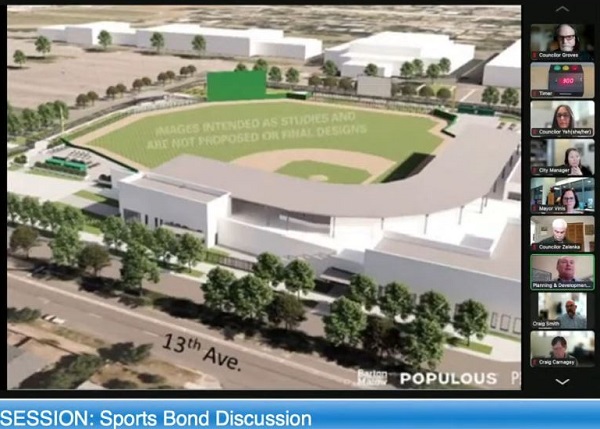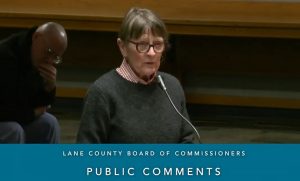Council breaks deadlock on new stadium for Emeralds
7 min read
The city council breaks the deadlock over a new stadium for the Eugene Emeralds. At the Nov. 15 work session:
Councilor Lyndsie Leech: I feel like we’re all kind of playing chicken and all of these different entities saying, like, ‘I want to wait for the county to make a decision.’ The county is probably saying, ‘Well, if the city is going to put in their money…’ and the state, and we’re all just kind of in this waiting zone. And so I think it’s going to take us making a decision to say, ‘I’m going to support this,’ for everyone to get on board and make sure that it’s a viable project.
[00:00:33] Councilor Randy Groves: I agree with Councilor Leech, somebody needs to make a movement. And I’m wondering: Could we vote on whether or not to refer a bond measure to the public and say, ‘This is contingent on the county doing…,’ and put some strings on it before it actually goes to the voters that have to be met by the county. Just so at least there is a pathway forward.
[00:00:56] Because I keep hearing from them they’re waiting to see if the city is going to support the $15 million contribution. And at some point, we just have to get down to what everybody’s doing and are we serious about this or are we not?
[00:01:13] Councilor Alan Zelenka: I think what we need to do is come up with a way to signal to the other folks involved in this that, ‘We support this and if the details are worked out, we put out a bond vote for this,’ so that part of our intent is clear.
So if the city council could figure out how to make that intent clear, that would be probably a really good step forward. (We) don’t necessarily have to act on a bond right away. We can wait for the details to get hammered out a little bit more.
[00:01:44] John Q: The city manager said the city would view the project as an investment.
[00:01:49] City Manager Sarah Medary: We don’t have the capacity to partner with the county on this project or be a partner in a multi-use facility, especially given that we weren’t part of the design and understanding of how it’s going to operate. I see us more as being an investor. This would be a $15 million city of Eugene community investment.
[00:02:08] And I think we could come back with a process or with a recommendation about how you could proceed with this to include something like what Councilor Groves was talking about, which is, ‘Hey, we’re willing to put this on the May ballot if the county or whoever is committed to the funding by whatever date,’ and they would have to do that by February, I think, for you to put it (on the ballot)—I think February is our deadline.
[00:02:29] John Q: City staff said Major League Baseball established new requirements, affecting cities across the country. Hillsboro is also looking at a new stadium for the Hops.
[00:02:40] Planning and Development Director Denny Braud: In 2020, Major League Baseball took over the minor league baseball system. So really two big things happened. First, they moved the Ems from Short A level to High A level, which is a good thing. They increased the number of games that the Ems play every year from about 76 per year to about 132 per year.
[00:03:01] At the same time, Major League Baseball also introduced a bunch of new stadium standards that all minor league baseball stadiums had to meet, things like locker rooms and lighting and training facilities and so forth. And PK Park did not meet those standards.
[00:03:16] There are about 120 minor league baseball stadiums across the country and these new standards have really caused cities across the country who have minor league baseball to consider the possibility of having to upgrade their existing stadiums or building new stadiums.
[00:03:31] So, Eugene is not a unique problem across the whole minor league system. And it’s really not a problem that was created by the Ems or the city or the U of O or the county. It’s really stadium standards that have been imposed by Major League Baseball.
[00:03:47] So the Ems were working with the U of O to determine if it was possible to upgrade PK Park to meet those standards. Ultimately, both the U of O and the Ems determined that there were just too many conflicts—scheduling, operational conflicts, wear and tear on the facility. The Ems actually play more games than the U of O and the Ems players didn’t have access to the field for practice for the most part, because the U of O team is using the facility most of the time, and that was a major issue for the players union who want access to a training facility.
[00:04:16] So the Ems approached us, made it clear that they really want to stay in Eugene. They’ve been very successful here. They developed a model minor league baseball program, an operation that gets a lot of recognition across the country.
[00:04:29] They’ve developed a lot of community support, they’ve provided a lot of support to the community as well over the 68 years that they’ve been in Eugene.
[00:04:37] So the county and the Ems, they worked together to develop a conceptual design and a cost estimate to determine the feasibility of a new multi-use stadium project. The plan would be to use the facility as a multi-use facility, so when it’s not being used by the Ems, it could be used and made available for other community events like concerts and youth sporting events, graduations, other community events. The conceptual design includes a capacity for 4,200 that could be expanded to approximately 10,000 (and it’s not really a hard number) but the capacity could be expanded for large events like concerts.
It also has indoor gathering space that could be used by the community. It has a kids’ playground area that they intend to have open to the community year-round as well.
[00:05:22] The county has indicated that a long-term operating agreement is being discussed with the Ems, but that has not yet been finalized. It is assumed that the facility would be owned by Lane County, the stadium would be leased by the Ems as the anchor tenant for part of the year. The Ems have indicated that they are interested in a long-term 20- or 30-year lease with options to extend beyond that term. So they hope to be there for a long time.
[00:05:48] The Ems have expressed an interest in managing, marketing, and programming the facility for non-Ems events in partnership with the county. It allows them to keep their staff fully engaged and employed throughout the year.
[00:06:00] The county has indicated that they’re looking at various revenue sources, such as ticket and parking surcharges and other facility lease revenue as a means for funding operating expenses and establishing a capital replacement reserve. Just for scale, they sell over 200,000 tickets a year.
[00:06:18] Total project cost is estimated at $100 million, which includes approximately $90 million for the multi-use stadium, another $10 million to relocate the existing livestock building to accommodate the stadium.
[00:06:30] The proposed contribution from the owners, at least as described by the Ems, towards the capital construction cost is approximately $13.5 million, which includes $10 million in prepaid rent (that was calculated at $500,000 a year over 20 years but all paid upfront), plus approximately $3.5 million towards equipment and fixtures for the project, which are part of the facility and used by all the users, things like concession equipment, tables, chairs, and etc.
[00:07:00] And I would just note that this prepaid lease concept is very similar to what the Ems did with the U of O. They prepaid a lease for PK Park in the amount of $2 million in order to help U of O build PK Park.
[00:07:15] That obviously leaves a sizable funding gap of $43 million.
[00:07:19] They’re asking the state for $15 million. They had a way to calculate the county’s participation, the land value and some other things, and they came up with a number of roughly $15 million from the county. The owners are in the $15 million neighborhood with their $13.5 million contribution. And so that’s how they derived the $15 million ask.
[00:07:43] Councilor Jennifer Yeh: So, yeah, I think this is really hard. Clearly, the Ems are a beloved local team. But I think we have a really high responsibility of how we use or ask for tax money. We have a similar-sized funding gap of our own that we need to deal with.
[00:07:58] I don’t want to be in a position where I’m cutting essential services because we asked the voters for money and it’s going for a baseball stadium instead of our police or fire or parks or libraries.
[00:08:12] It’s all coming out of the same pot, and we know our community is not a wealthy community. Many folks are struggling right now today to pay their bills. So, adding on to that burden, it should be for something that really matters and we should take it very seriously.
[00:08:30] I don’t feel like it’s smart to pretend that they’re somehow don’t affect each other. And we’re at a point now that we’re talking about a lot of jobs and a lot of real people in our community who could be out of work because we have to start making serious cuts. And pretending that that and a baseball stadium are equivalent—I don’t know. I’m very uncomfortable with where we’re at. I think that’s probably obvious. But right now, it just doesn’t feel like a good investment to me, you know.
[00:08:58] John Q: The city breaks the deadlock and indicates interest in letting voters decide whether a new stadium for the Ems will be a good investment.




